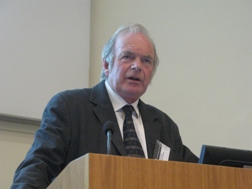
Ian Randall attended a policy discussion at Burlington House timed to coincide with the publication of incoming President Bryan Lovell’s new book.
Geoscientist Online Special 10 February 2010
On 25 November, Dr Bryan Lovell presented a lecture on geological aspects of climate change and carbon sequestration, the theme of his new book Challenged by Carbon: The Oil Industry and Climate Change. The talk, given at Burlington House before a packed audience of Fellows and Friends, academics, oil-industry professionals, policy-makers and opinion-formers, was followed by an extended and vigorous debate, chaired by President Professor Lynne Frostick. Participants in the debate included several of the characters featured in Lovell’s book, among them Dr Andy Chadwick of BGS, Dr David Jenkins of BHP Billiton and Dr Jeremy Leggett of Solarcentury. The talk and debate can be viewed online at
www.geolsoc.org.uk/challenged_by_carbon.
President-designate Lovell told the audience that the previously sceptical oil industry was now increasingly convinced that human-induced climate change was a significant problem. He suggested that this new conviction arises primarily from geological evidence, especially from work in the last decade analysing ancient ‘blasts of carbon’ on a timescale of thousands rather than millions of years. This high-definition analysis of sedimentary rocks brings us a warning message. The release of over 1000 gigatonnes of carbon that caused the Paleocene-Eocene Thermal Maximum 55 million years ago was followed by major disruption of life worldwide: a clear indication of the deleterious effects of our own comparable release of carbon to the atmosphere (so far well over 300 gigatonnes). The developing change of heart by the oil industry really does matter: we need petroleum engineers and petroleum geologists to play a key role in the vital business of subsurface storage of carbon dioxide to counteract that present-day release of carbon.
Lovell, formerly with Edinburgh University, then with BP Exploration, now at Cambridge University, said that the prospective use of oil-industry skills “raised the possibility that we could not only pump carbon dioxide underground, but also engineer reservoirs to ensure ample safe storage.” An industry devoted to injection of carbon, comparable in scale to the existing industry that extracts carbon for our eager use, would be required to make any significant impact on published targets for cutting carbon emissions. (Lovell here quoted the numbers for cuts proposed by Robert Socolow and Stephen Pacala of Princeton University in Science 2004.)
Each day, the oil industry recovers some 80 million barrels of oil, plus even more water – well over 300 million barrels of fluid in total. The industry is already familiar with injection as well as extraction of fluids. “If we were to reverse that total daily flow, pumping compressed carbon dioxide safely underground, we would cope with most of the Princeton target through to 2050”, Lovell explained. “That isn’t going to happen, but it gives an idea of the scale of the contribution that could be made.”
Carbon dioxide could be captured most effectively from large coal-fired power stations, not least in China and India. Space could be found both in reservoirs that once contained oil and gas, and in those that did not. Government regulation leading to an adequateprice for each tonne of carbon dioxide safely stored was an “essential first step.”
While urging a new service-industry role in carbon storage on the oil companies, Lovell was keen to stress that this new business should be regarded as a transitional measure for the first half of this century. Carbon capture and storage can help to get us through the first phase of our move to a low-carbon economy, “but in the long term we will derive our energy from the Sun directly. Somehow we have to manage the transition from here to there”.
Lovell is emphatic that geology is crucial to that transition.
- Challenged by Carbon: The Oil Industry and Climate Change is published by Cambridge University Press. The Geological Society features strongly in its pages, notably the Burlington House meeting in 2003 on ‘Coping with Climate Change’ (www.geolsoc.org.uk/cwcc), which included the historic debate between BP and ExxonMobil, and the 2005 joint-societies multidisciplinary meeting on ‘Challenges and Solutions: UK Energy to 2050’ (www.geolsoc.org.uk/energy2050). The coda of the book is based on Lovell’s three-part essay published in Geoscientist in 2008: ‘The Proof in the Puddingstone’